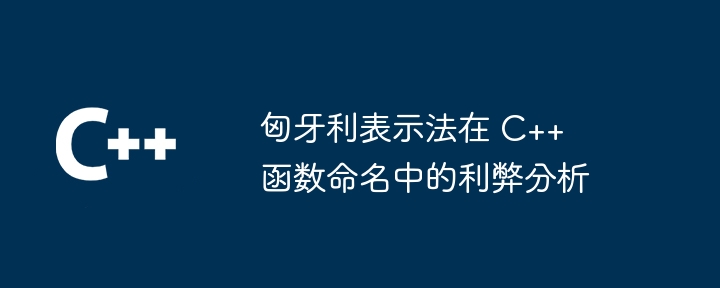
Hungarian notation is a C function naming convention that indicates data types through prefixes to improve readability, reduce errors, and enhance maintainability. However, it will lengthen the function name, increase maintenance difficulty, and may conflict with some style guides.

Hungarian notation: pros and cons of C function naming
Introduction
Hungary Notation is a naming convention used to specify the data types of variables and function parameters in C functions. This convention uses prefixes to indicate data types, which helps improve code readability.
Pros and cons
Advantages:
Disadvantages:
Practical case
The following example demonstrates the advantages of using Hungarian notation in C function naming:// 使用匈牙利表示法
void print_int(int n) {
std::cout << "Integer: " << n << std::endl;
}
void print_double(double d) {
std::cout << "Double: " << d << std::endl;
}
// 用户代码
int main() {
print_int(42);
print_double(3.14);
return 0;
}i and d) in the function name clearly indicate the data type of each parameter. This makes the code easier to understand and helps avoid data type mismatch errors.
Conclusion
Hungarian notation is a controversial convention for specifying data types in C function naming. While it has the advantages of improved readability, fewer errors, and improved maintainability, it can also lead to lengthy function names, maintenance difficulties, and conflicts with certain coding style guides. Ultimately, the decision to use Hungarian notation depends on the style guide of the specific project and the developer's personal preferences.The above is the detailed content of Analysis of the pros and cons of Hungarian notation in C++ function naming. For more information, please follow other related articles on the PHP Chinese website!
 What are the differences between c++ and c language
What are the differences between c++ and c language
 Recommended learning order for c++ and python
Recommended learning order for c++ and python
 Cost-effectiveness analysis of learning python and c++
Cost-effectiveness analysis of learning python and c++
 Is c language the same as c++?
Is c language the same as c++?
 Which is better to learn first, c language or c++?
Which is better to learn first, c language or c++?
 The difference and connection between c language and c++
The difference and connection between c language and c++
 C++ software Chinese change tutorial
C++ software Chinese change tutorial
 Cost-effectiveness analysis of learning python, java and c++
Cost-effectiveness analysis of learning python, java and c++




